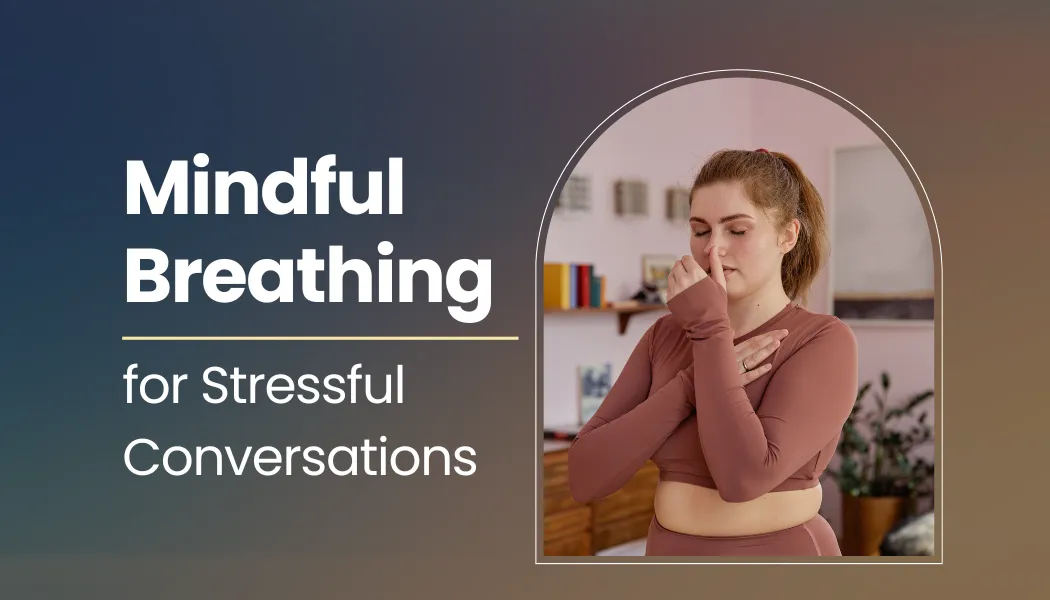Conversations are at the heart of human connection. They shape our relationships, build trust, and resolve conflicts. Yet, sometimes, they also spark tension, misunderstanding, or stress. Whether it’s a heated workplace meeting, a disagreement with a partner, or an emotionally charged family discussion, conversations can often feel overwhelming. In those moments, our bodies tend to react before our minds even catch up—we feel our chest tighten, our breath shorten, and our words stumble out faster than we’d like.
This is where mindful breathing comes in—not as a magic wand to erase conflict, but as a tool to steady ourselves, regulate emotions, and create the conditions for healthier dialogue. Mindful breathing allows us to notice our body’s reactions in the heat of conversation and gently bring ourselves back to calm, clarity, and presence.
In this article, we’ll dive deeply into the practice of mindful breathing during stressful conversations, exploring why it works, how to use it in real-life situations, and how to build habits that transform not just conversations, but also our relationships with others—and ourselves.
Table of contents
- Why Stressful Conversations Feel Overwhelming
- The Science Behind Mindful Breathing
- Techniques for Mindful Breathing During Stressful Conversations
- Real-Life Scenarios: Applying Mindful Breathing
- Building a Habit of Mindful Breathing
- The Ripple Effects of Mindful Breathing
- Stories of Transformation
- Mindful Breathing as a Life Skill
- Final Thoughts
Why Stressful Conversations Feel Overwhelming
Before understanding why mindful breathing helps, it’s important to recognize why conversations can trigger such intense reactions.
- Fight-or-Flight Response
Our nervous system is wired to detect threats, and a stressful conversation can feel like one. Even if no physical danger exists, criticism, conflict, or perceived rejection can activate the amygdala, pushing us into fight, flight, or freeze mode. This is why voices rise, words stumble, or we mentally shut down. - Emotional Baggage
Conversations rarely happen in a vacuum. They carry layers of personal history, unresolved tensions, and hidden expectations. What may seem like a simple disagreement about chores could trigger deeper emotions tied to fairness, respect, or belonging. - Loss of Control
Humans crave stability. In conversations where emotions escalate, we often feel like we’re losing control—over the outcome, over how others see us, and over our own reactions. This sense of instability amplifies stress. - Physiological Effects
Stress shows up in the body. Rapid heartbeat, sweaty palms, shaky hands, and shallow breathing are all signs of heightened stress. Among these, breathing is unique because, unlike heart rate or sweating, it is something we can consciously control.
This is the key—breathing is both involuntary and voluntary, bridging body and mind. When we consciously regulate it, we influence our nervous system and shift from stress to steadiness.
The Science Behind Mindful Breathing
Mindful breathing is not just a wellness trend; it is backed by neuroscience and physiology.

- Activating the Parasympathetic Nervous System
Slow, deep breaths signal safety to the body. This activates the parasympathetic nervous system (the “rest and digest” system), lowering heart rate and blood pressure while easing tension. - Interrupting Automatic Reactions
By bringing attention to the breath, we create a pause between stimulus (someone’s words) and our reaction. This gap is where choice lives—the choice to respond with clarity instead of reacting impulsively. - Boosting Oxygen and Focus
Shallow breathing reduces oxygen flow to the brain, impairing focus. Deep mindful breathing restores oxygenation, helping us think more clearly, even under pressure. - Emotional Regulation
Studies in mindfulness psychology show that consistent breathing practices increase emotional resilience, allowing people to face stressful situations with greater calm.
In short: mindful breathing is not about escaping stress, but about meeting it with a steady presence.
Techniques for Mindful Breathing During Stressful Conversations
Here are practical techniques you can use when you find yourself in tense dialogue:
1. The Pause Breath
Before responding, take a single deep inhale through your nose and exhale slowly through your mouth. This micro-pause is often enough to prevent reactive words.
2. The 4-4-6 Breath
- Inhale for 4 counts.
- Hold gently for 4 counts.
- Exhale for 6 counts.
This longer exhale signals relaxation, softening tension in both body and voice.
3. Grounded Breathing with Awareness
While listening, silently notice: “Breathing in, I am aware of this breath. Breathing out, I am letting go.” This subtle awareness anchors you in the present, reducing mental spiraling.
4. Co-Regulation with Others
If the situation allows (like with family or close friends), suggest pausing for a shared breath. Breathing together creates physiological harmony and softens defensiveness.
5. Posture + Breath
Unclench your jaw, drop your shoulders, and sit upright. Pairing mindful breathing with posture shifts signals confidence and calm.
These techniques are small, almost invisible, but their effects ripple powerfully into how conversations unfold.
Real-Life Scenarios: Applying Mindful Breathing
To understand how mindful breathing transforms stressful conversations, let’s walk through some examples.
At Work: Handling Criticism from a Manager
Your boss points out mistakes in your project. Immediately, your body tenses, and defensiveness rises. Instead of interrupting or mentally shutting down, you take one deep breath before responding. The pause helps you listen fully, gather your thoughts, and reply professionally. The outcome: a more constructive conversation and preserved respect.
At Home: Resolving Conflict with a Partner
During an argument, emotions escalate, and both of you raise your voices. You notice your shallow breathing and choose to slow it down deliberately. As you exhale, your voice softens. This physiological calm shifts the tone, encouraging your partner to mirror your steadiness. The conflict becomes dialogue instead of a battle.
With Family: Difficult Discussions
Conversations about finances, caregiving, or personal choices can get heated in families. Here, mindful breathing acts as a silent anchor. Each time you feel triggered, you focus on your breath for a few seconds before speaking. The result: fewer regrettable words and more space for understanding.
In Friendships: Navigating Misunderstandings
Friends may unintentionally say hurtful things. Instead of reacting immediately, mindful breathing creates a moment to check whether your reaction is from hurt or clarity. This helps preserve the friendship by reducing unnecessary conflict.
Building a Habit of Mindful Breathing
Practicing mindful breathing during stressful conversations becomes easier when it’s already part of your daily life. Here’s how to build the habit:
- Daily Practice
Spend 5–10 minutes each day focusing on your breath. Apps, guided meditations, or even silent pauses can help. - Anchor Breathing to Routine
Take three deep breaths each time you open your laptop, enter a meeting, or step into a difficult discussion. Over time, this becomes second nature. - Body Awareness
Notice where you hold tension—jaw, shoulders, chest. Pair mindful breathing with releasing these areas during the day. - Reflect After Conversations
After a stressful talk, ask yourself: Did I breathe mindfully? What difference did it make? Reflection strengthens awareness for next time. - Practice in Small Moments
Even waiting in line or sitting in traffic can become an opportunity to breathe mindfully. These mini-practices prepare you for bigger challenges.
The Ripple Effects of Mindful Breathing
Mindful breathing is not just a private tool; it reshapes relationships and communication patterns:

- Deeper Listening: When you are calm, you hear not just words, but the emotions behind them.
- More Thoughtful Responses: Breathing gives time to choose words that heal rather than hurt.
- Reduced Conflict Escalation: A calm presence often diffuses the other person’s defensiveness.
- Modeling Calm for Others: Your steady breathing and responses encourage others to mirror calmness.
- Improved Well-Being: Regular mindful breathing reduces chronic stress, benefiting overall mental and physical health.
Stories of Transformation
Sarah’s Workplace Breakthrough
Sarah, a project manager, often felt overwhelmed during team meetings where conflicts arose. By practicing mindful breathing, she noticed her tendency to interrupt faded. Over time, colleagues appreciated her calm leadership, and meetings became more productive.
John and His Teenage Daughter
Arguments with his daughter used to escalate quickly. When John started pausing for a slow breath before responding, he found his daughter mirrored his calm. Conversations shifted from shouting matches to open dialogues.
A Couple’s Journey
Emily and Mark, in couples therapy, were taught mindful breathing during conflicts. At first, it felt awkward. But gradually, breathing together during heated arguments gave them a sense of teamwork. They described it as “holding onto calm instead of clinging to anger.”
Mindful Breathing as a Life Skill
Ultimately, mindful breathing is not just about surviving stressful conversations—it is about thriving in relationships. It helps us cultivate presence, patience, and compassion in moments where these qualities matter most.
Every conversation has two layers: the content (what is being said) and the connection (how it feels to both people). Mindful breathing strengthens the second layer, creating a space where honesty, kindness, and understanding can live.
When we breathe mindfully, we send a powerful message—to ourselves and to others: This moment matters. I choose presence over reactivity. I choose connection over conflict.
Final Thoughts
Stressful conversations will always exist; they are a part of life and growth. But how we meet them is within our control. Mindful breathing offers a gentle yet powerful way to bring calm to the chaos of communication. By practicing it consistently, we can transform not just how we talk, but also how we live, love, and lead.
Next time you feel tension rise, pause. Breathe in. Breathe out. Let your breath guide you back to presence—and let that presence shape the words that follow.
